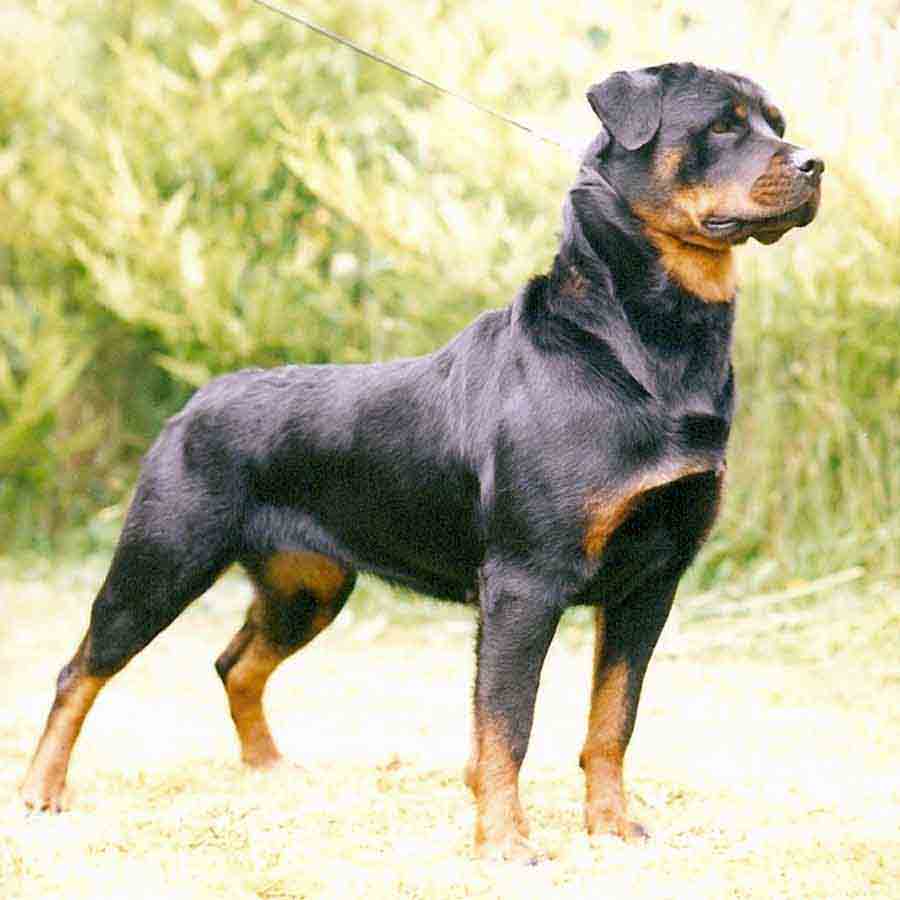
Rottweiler

Navigate through the tabs
Navigate through the tabs below to view the breed's info of your interest.
The breed's info is divided in four sections; namely:
the breed's history ,
the breed's main stats ,
the dog's potential health issues
and finally, how the breed scored in 26 different categories.
All the above information should give you a respectively good overview for the dog of your interest.
Dog Breed's Main Info
The Breed's History:
Although a versatile breed used in recent times for many purposes, the Rottweiler is one of the oldest of herding breeds. A multi-faceted herding and stock protection dog, it is capable of working all kinds of livestock under a variety of conditions.
The breed's history likely dates to the Roman Empire. It is likely that the Rottweiler is a descendant of ancient Roman drover dogs, a mastiff-type dog that was a dependable, rugged dog with great intelligence and guarding instincts. During their quest to conquer Europe, the Roman legion traveled in large numbers across the continent.
The non-existence of refrigeration meant the soldiers had to bring herds of cattle with them on their excursions for food. These drover dogs were not only used to keep the herds of cattle together, but to guard the supply stock at night.
Around 74 A.D. the Roman army travelled across the alps and into the southern part of modern day Germany. For the next two centuries the Roman drover dogs were continually used in herding and driving cattle for trade even after the Romans were driven out of the area by the Swabians.
A town in this region was eventually given the name Rottweil. It became an important trade center and the descendants of the Roman cattle dogs proved their worth by driving the cattle to market and protecting the cattle from robbers and wild animals. The dogs are said to have been used by traveling butchers at markets during the Middle Ages to guard money pouches tied around their necks.
The dogs eventually came to be called Rottweiler Metzgerhunds, or butcher dogs. As railroads became the primary method for moving stock to market, the need for the breed declined, as did the number of Rottweilers.
The number of Rottweilers diminished so severely that by 1882 in a dog show in Heilbronn, there was only one very poor representative of the breed.
The buildup to World War I saw a great demand for police dogs, and that led to a revival of interest in the Rottweiler. During the First and Second World Wars, Rottweilers were put into service in various roles, including as messenger, ambulance, draught, and guard dogs.
The Deutscher Rottweiler-Klub (DRK, German Rottweiler Club), the first Rottweiler club in Germany, was founded on 13 January 1914, and followed by the creation of the Suddeutscher Rottweiler-Klub (SDRK, South German Rottweiler Club) on 27 April 1915 and eventually became the IRK (International Rottweiler Club). The DRK counted around 500 Rottweilers, and the SDRK 3000 Rottweilers.
The goals of the two clubs were different. The DRK aimed to produce working dogs and did not emphasise the morphology of the Rottweiler.
The various German Rottweiler Clubs amalgamated to form the Allgemeiner Deutscher Rottweiler Klub (ADRK, General German Rottweiler Club) in 1921. This was officially recorded in the register of clubs and associations at the district court of Stuttgart on 27 January 1924. The ADRK is recognised worldwide as the home club of the Rottweiler.
In 1931 the Rottweiler was officially recognised by the American Kennel Club. In 1936, Rottweilers were exhibited in Britain at Crufts. In 1966, a separate register was opened for the breed. In fact, in the mid-1990s, the popularity of the Rottweiler reached an all-time high with it being the most registered dog by the American Kennel Club. In 2013, the American Kennel Club ranked the Rottweiler as the 9th most popular purebreed in the United States.
Country of Origin:
Germany
Breed Group:
Working
Height:
1 foot, 10 inch. to 2 feet, 3 inch. (55,88 to 68,58 cm)
Weight:
85 to 130 pounds (38,55 to 58,97 Kg)
Life Span:
8 to 11 years
Potential Health Issues:
Elbow Dyplasia,
Hip Dysplasia,
Aortic Stenosis/Sub-aortic Stenosis (AS/SAS),
Osteosarcoma,
Gastric Dilatation-volvulus (GDV) - aka Bloat or Torsion,
Hypothyroidism,
Panosteitis (Pano),
Allergies
Adaptability
Apartment Living:
First Time Owners:
Sensitivity:
Being Alone:
Cold Weather:
Hot Weather:
Friendliness
Affection With Family:
With Kids:
With Dogs:
With Strangers:
Health and Grooming
Shedding:
Drooling:
Easy To Groom:
Overall Health:
Weight Gain Potential:
Size:
Training
Easiness:
Intelligence:
Mouthiness:
Prey Drive:
Barking or Howling:
Wanderlust:
Need For Exercise
Energy Level:
Intensity:
Exercise Needs:
Playfulness:
Our Mobile Application
Check out Our Mobile Application "Dog Breeds Central"
